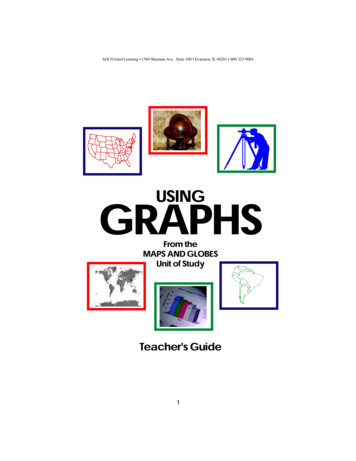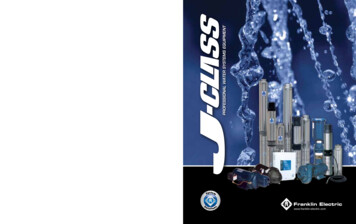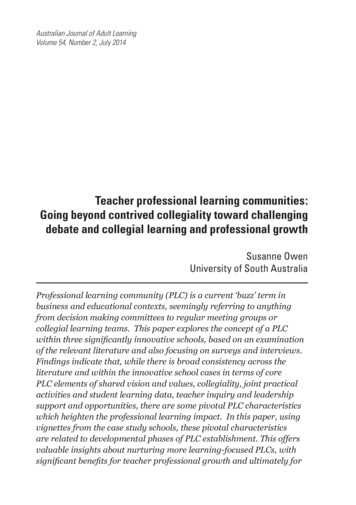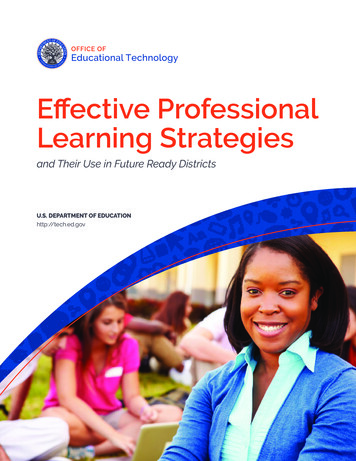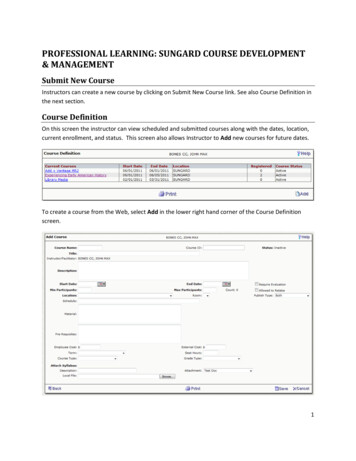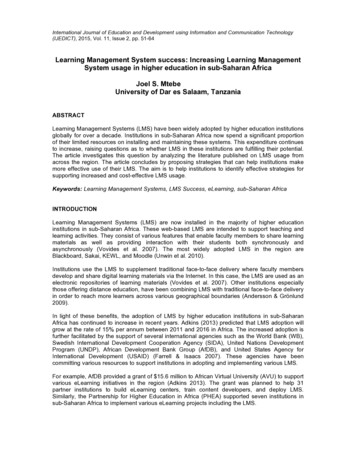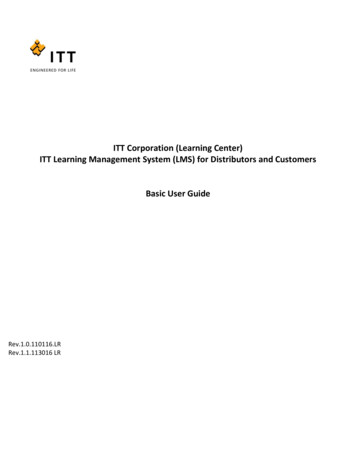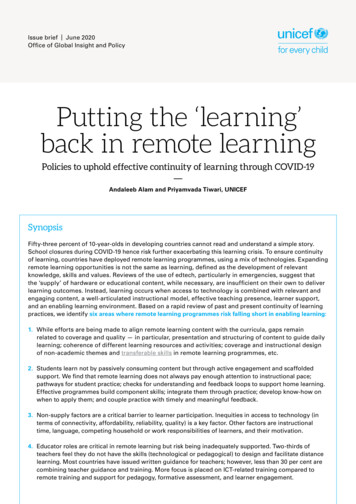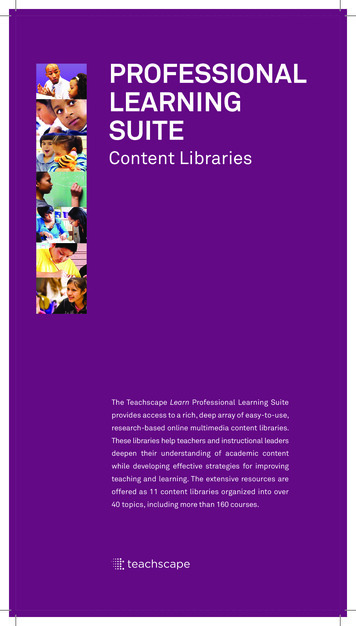
Transcription
PROFESSIONALLEARNINGSUITEContent LibrariesThe Teachscape Learn Professional Learning Suiteprovides access to a rich, deep array of easy-to-use,research-based online multimedia content libraries.These libraries help teachers and instructional leadersdeepen their understanding of academic contentwhile developing effective strategies for improvingteaching and learning. The extensive resources areoffered as 11 content libraries organized into over40 topics, including more than 160 courses.
Content LibrariesFeatured ExpertsTHE COMMON CORE SERIESCommon Core State Standards for MathematicalPractice Introduction to the Standards for MathematicalPractice Practice Standard 1: Make Sense of Problems andPersevere in Solving Them Practice Standard 2: Reason Abstractly andQuantitatively Practice Standard 3: Construct Viable Arguments andCritique the Reasoning of Others Practice Standard 4: Model with Mathematics Practice Standard 5: Use Appropriate Tools Strategically Practice Standard 6: Attend to Precision Practice Standard 7: Look for and Make Use of Structure Practice Standard 8: Look for and Express Regularity inRepeated Reasoning Applying Instructional StrategiesDr. Amy EllisDr. Eric KnuthCommon Core State Standards for English LanguageArts & Literacy Introduction to the Common Core State Standards forEnglish Language Arts & Literacy Balancing Informational and Literary Text Integrating Literacy in the Disciplines Increasing Text Complexity Prioritizing Text-Based Evidence Focusing on Academic Vocabulary Teaching Case (K-5): Balancing Main Topic and MainIdea in Nonfiction Texts Teaching Case (6-8): Debating the New Deal Teaching Case (9-12): Discussing Themes in a SocraticSeminar Teaching Case (K-2): Using Nonfiction Text Features Teaching Case (11-12): Examining Advertisements Teaching Case (6-8): Analyzing the Script of a Play Considering Implicit Aspects of the Common Core StateStandards for ELA & LiteracyDr. Peter AfflerbachDr. Robert AndersonDr. P. David PearsonDr. Karen SchaafsmaDr. Dorothy StricklandTHE COMPETENCY-BASED LEARNING SERIES Backwards Design Understanding Cultural and Socioeconomic Diversityin Schools Considering Technology Tools for Your Classroom Setting Up Your Classroom Motivation in a Culture for Learning Establishing Expectations for Classroom Procedures Creating a Positive, Respectful Classroom Environment Managing Student Behavior Asking Effective Questions Monitoring Student Learning Being Responsive and Flexible Engaging Students with Collaborative Learning andRelevant Tasks1Grant WigginsJay McTighePaul EggenDonald KauchakCharlotte DanielsonTom MalarkeyDr. Robert MarzanoDeborah StipekDr. Susan LandryDr. Carolyn Evertson
Content LibrariesFeatured ExpertsTHE COMPETENCY-BASED LEARNING SERIES (cont’d) The Importance of Reflection Maintaining Accurate Records to Monitor StudentProgress Communicating with and Engaging Families Professional Learning Communities Service to Students Being Receptive to Feedback Using Non-Linguistic Representations to EngageStudents in Learning Using Online Learning for Professional Development Setting Effective Instructional Objectives Designing Effective Student AssessmentsTHE DATA-DRIVEN INSTRUCTION SERIESLeading a Data-Focused School Finding Focus and Getting Results Leading and Supporting Effective Work with DataKay BurkeJay McTigheGrant WigginsUsing Student Data to Improve Instruction Data-Focused Instructional Decision Making Effective Formative AssessmentBetsy EavesLyn ReggettJoan KenneyImplementing the Classroom Walkthrough Process Introduction to Classroom Walkthrough Implementation and Practice of Classroom Walkthrough Data Analysis and Reflection Using ClassroomWalkthroughDr. Ray GarciaTom MalarkeyDr. Ann LiebermanCarole WilliamsExamining Evidence of Effective Teaching Establishing a Culture of Reflective Practice Implementing Video-Based Classroom Observations Implementing In-Classroom ObservationsCharlotte DanielsonFrank DeStefanoMiriam Gamoran SherinTHE EFFECTIVE INSTRUCTIONAL STRATEGIES SERIESHigh Yield Strategies: The Foundation High Yield Strategies Overview Planning for the High Yield StrategiesDr. Ceri DeanElizabeth Ross HubbellDr. Robert MarzanoCreating the Environment for Learning Setting Objectives and Providing Feedback Reinforcing Effort and Providing Recognition Cooperative LearningDr. Ceri DeanElizabeth Ross HubbellDr. Robert MarzanoHelping Students Develop Understanding Cues, Questions, and Advance Organizers Nonlinguistic Representations Summarizing and Note-Taking Homework and PracticeDr. Ceri DeanJane DotyElizabeth Ross HubbellDr. Robert MarzanoDr. Howard Pitler2
Content LibrariesFeatured ExpertsTHE EFFECTIVE INSTRUCTIONAL STRATEGIES SERIES (cont’d)Helping Students Extend and Apply Knowledge Nonlinguistic Representations Generating and Testing Hypotheses Identifying Similarities and DifferencesDr. Ceri DeanJane DotyElizabeth Ross HubbellDr. Robert MarzanoDr. Howard PitlerInstructional Strategies to Improve Student Achievement Direct Instruction Differentiating Instruction Scaffolding in ActionKathleen C. BuzadBetsy EavesLyn ReggettStrategies to Deepen Student Learning Foundations of Effective Teaching Data-Focused Instructional Decision Making Understanding Student NeedKathleen C. BuzadBetsy EavesLyn ReggettTHE ELEMENTARY SCIENCE SERIESThe Earth Science Series Investigating the Properties of Minerals: The 5 E’s Science as Inquiry: Investigating ErosionDr. Roger BybeeDr. Susan Loucks-HorsleyThe Physical Science Series Investigating Density: Why Objects Sink or Float Magnetism: Using Questions to Guide LearningDr. Roger BybeeDr. Susan Loucks-HorsleyTHE ENGLISH LANGUAGE LEARNERS SERIESDeveloping English Language Skills English Language Learners: Listening and Speaking English Language Learners: Reading and WritingDr. Susan BakerDr. Kenji HakutaEnglish Language Skills for Middle School Students English Language Development at Middle SchoolDr. Guadalupe ValdésEnglish Language Skills for High School Students English Language Development at High SchoolDr. Guadalupe ValdésUsing SDAIE to Promote English Language Development Using SDAIE for English Language Learners Teaching High School Math Using SDAIE Methodology Teaching High School Science Using SDAIE MethodologyDr. Kenji HakutaDr. Robert LinquantiDr. Judit MoschkovichPromoting English Language Learning: The LeadershipPerspective ELLs and the Law Second Language Acquisition Theory Characteristics of Immigrant ELLs Teaching Strategies for Content Instruction Teaching Strategies for English Language Development ELLs and Accountability ELLs and AssessmentDr. Kenji HakutaDr. Robert LinquantiDr. Amada PadillaDr. Guadalupe Valdés3
Content LibrariesFeatured ExpertsTHE LITERACY SERIESFoundations of Effective Literacy Practice Foundations of Teaching Reading: Phonemic Awareness Foundations of Teaching Reading: Phonics Foundations of Teaching Reading: Vocabulary Foundations of Teaching Reading: Fluency Foundations of Teaching Reading: Comprehension Foundations of Teaching Writing Foundations of Teaching Reading and Writing:Putting It All TogetherDr. Isabel BeckDr. Connie JuelDr. Catherine SnowDr. Dorothy StricklandUnderstanding the Research Base: Perspectives fromthe Experts Early Reading Success, Edward Kame’enui Comprehension and Vocabulary Development,Isabel Beck Effective Comprehension Instruction, Michael Pressley Methods to Teach Children to Read, Sally Shaywitz Preventing Reading Failures, Reid Lyon Reading Instruction and the Importance of TeacherPreparation, Louisa MoatsDr. Edward Kame’enuiDr. Isabel BeckDr. Michael PressleyDr. Sally ShaywitzDr. Reid LyonDr. Louisa MoatsEvidence-Based Practices in Teaching Reading:Reading FirstDr. Isabel BeckDr. Nell DukeDr. Connie JuelDr. Louisa MoatsDr. Catherine Snow Phonemic Awareness and Phonics Letter-Sound Correspondences Word Building Fluency Vocabulary Development Talking About Texts Comprehension StrategiesBest Practices in Teaching Writing Organizing for Writing Writing Conferences Sharing and PublishingDr. Dorothy StricklandEffective Literacy Practices Scaffolding in Action Differentiating InstructionDr. Irene GaskinsDr. David RoseEssential Readings in Literacy Book Review: Overcoming Dyslexia, Sally Shaywitz Book Review: Speech to Print: Language Essentialsfor Teachers, Louisa Moats Book Review: The Academic Achievement Challenge:What Really Works in the Classroom, Jeanne ChallDr. Sally ShaywitzDr. Louisa MoatsDr. Jeanne ChallEssential Readings in Literacy Teaching Vocabulary (Project CORE: EnglishLanguage Arts) Providing Text Evidence (Project CORE: EnglishLanguage Arts) Analyzing Text Structures (Project CORE: EnglishLanguage Arts)Dr. Don Deshler4
Content LibrariesFeatured ExpertsTHE MATHEMATICS SERIESFoundations of Effective Mathematics Teaching Foundations of Effective Mathematics Teaching Effective Questioning in the Mathematics Classroom Formative Assessment in the Mathematics Classroom Problem Solving in MathematicsDr. Diane BriarsDr. Susan B. EmpsonNumber and Operations Broken Calculator Division and Remainders The Magnitude of FractionsDr. Susan B. EmpsonDr. Marvin CohenDr. Judith CollisonOperations and Algebraic Thinking Pre-Algebra: Pan Balance Equations Pre-Algebra: Patterns and FunctionsDr. James KaputDr. Judah SchwartzGeometry 2D and 3D Figures Calculating the Area of a TriangleDr. Fadia HarikDr. Judah SchwartzStatistics and Probability Data Analysis Data Analysis and Probability: Measures of Center Data Analysis and Probability: Using Data to MakePredictionsDr. Lucille PetersonDr. Richard LeshDr. Joseph GarofaloMeasurement and Data 2D and 3D Figures Calculating the Area of a TriangleDr. Fadia HarikDr. Judah SchwartzRatios and Proportional Relationships Proportional Reasoning Proportional Reasoning in the Middle GradesAlgebra, Functions, and Modeling Linear Functions Transformations of Linear Functions Linear Equations Systems of Linear Equations Quadratic Functions Quadratic Equations Transformations of Quadratic Functions Operations on Numbers and Expressions Linear Equations and Inequalities for Algebra II Linear Systems for Algebra II Quadratic Functions for Algebra II Transformations of Quadratic Functions for Algebra II Exponential Functions Function Operations and Inverses Higher Order Polynomial and Rational Functions5Dr. Richard LeshDr. Judith CollisonDr. James KaputDr. Diane BriarsDr. Dan ChazanDr. Deborah SchifterDr. Amy EllisDr. Debe KincaidDr. Eric KnuthDr. Bill Nielsen
Content LibrariesFeatured ExpertsTHE NEW TEACHER SUPPORT SERIESClassroom Management Beginning of the Year Classroom Management Secondary Classroom ManagementDr. Carolyn M. EvertsonLyn ReggettEssential Teaching Strategies Foundations of Effective TeachingFrank AtchisonDecision Making for Student Achievement Data-Focused Instructional Decision MakingDr. Robert MarzanoDeepening Understanding of Student Learning Needs Understanding Student NeedDr. Robert MarzanoEffective Instructional Planning Design for LEARNingDr. Robert MarzanoTeaching with High Yield Strategies: The EssentialFoundation High Yield Overview Setting Objectives and Providing FeedbackDr. Robert MarzanoTHE EARLY CHILDHOOD SERIESLeading and Mentoring Effective Early ChildhoodPractices Leading School-Wide Improvement Effective Mentoring StrategiesSupporting Emerging Literacy Setting the Stage for Children’s Talk Read Alouds Building Vocabulary Phonological Awareness Letter Knowledge Written ExpressionDr. Susan LandrySusan GunnewigDr. Susan LandryDr. Christopher LoniganDr. Carola MateraDr. Lesely Mandel MorrowDr. Kathleen RoskosDr. Emily SolariDr. Dorothy StricklandSupporting Math and Science Development Early Childhood Mathematics Discovering Early Childhood ScienceDr. Susan LandrySupporting Early Learning Classroom Management Pre-Kindergarten Response to Intervention Understanding Special Needs Social and Emotional Learning English Language Learners: Culture, Language,Instruction6Dr. Susan Landr
877. 98.TEACHinfo@teachscape.com71 Stevenson St., 20th FloorSan Francisco, CA 94105www.teachscape.com
Practice Standard 5: Use Appropriate Tools Strategically Practice Standard 6: Attend to Precision Practice Standard 7: Look for and Make Use of Structure Practice Standard 8: Look for and Express Regularity in Repeated Reasoning Applying Instructional Strategies Dr. Amy Ellis Dr. Eric Knuth Common Core State Standards for English Language Arts & Literacy Introduction to .


